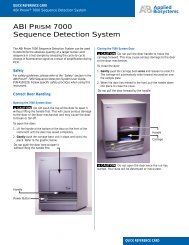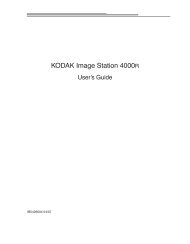ABI PRISM 7000 Sequence Detection Systems Relative ...
ABI PRISM 7000 Sequence Detection Systems Relative ...
ABI PRISM 7000 Sequence Detection Systems Relative ...
Create successful ePaper yourself
Turn your PDF publications into a flip-book with our unique Google optimized e-Paper software.
Selecting the <strong>Sequence</strong> <strong>Detection</strong> Chemistry and Reagent Configuration<br />
About SDS Chemistries<br />
Selecting the <strong>Sequence</strong> <strong>Detection</strong> Chemistry and Reagent<br />
Configuration<br />
About SDS<br />
Chemistries<br />
Applied Biosystems offers two types of chemistries that can be used to detect PCR<br />
products on SDS instruments, as explained in the following table. For more information<br />
about SDS chemistries, refer to the <strong>Sequence</strong> <strong>Detection</strong> <strong>Systems</strong> Chemistry Guide.<br />
Chemistry<br />
Process<br />
TaqMan ® reagents or kits<br />
Polymerization<br />
Strand Displacement<br />
Description<br />
TaqMan reagent-based chemistry uses a<br />
fluorogenic probe to enable detection of a specific<br />
PCR product as it accumulates during PCR cycles.<br />
Advantages<br />
• Increases specificity with a probe. Specific<br />
hybridization between probe and target<br />
generates fluorescent signal.<br />
• Provides multiplex capability<br />
• Optimized assays available<br />
• Allows 5′ -nuclease assay to be carried out<br />
during PCR<br />
FORWARD<br />
PRIMER<br />
5′<br />
3′<br />
R<br />
PROBE<br />
Q<br />
3′<br />
R = REPORTER<br />
Q = QUENCHER<br />
5′<br />
5′ 3′<br />
5′<br />
REVERSE<br />
PRIMER<br />
Step 1: A reporter (R) and a<br />
quencher (Q) are attached to the<br />
5' and 3' ends of a TaqMan<br />
probe.<br />
Cleavage<br />
5′<br />
3′<br />
R<br />
Q<br />
3′<br />
5′ 3′<br />
5′<br />
5′<br />
5′<br />
3′<br />
R<br />
Q<br />
3′<br />
5′ 3′<br />
5′<br />
Step 1 continued: when both dyes<br />
are attached to the probe, reporter<br />
dye emission is quenched.<br />
Polymerization Completed<br />
5′<br />
3′<br />
5′ 3′<br />
5′<br />
R<br />
Q<br />
3′<br />
5′<br />
5′<br />
2<br />
Step 2: During each extension<br />
cycle, the AmpliTaq Gold ® DNA<br />
polymerase cleaves the reporter<br />
dye from the probe.<br />
Step 3: Once separated from the<br />
quencher, the reporter dye emits<br />
its characteristic fluorescence.<br />
SYBR ® Green I reagents<br />
Description<br />
Uses SYBR Green I dye, a double-stranded DNA<br />
binding dye, to detect PCR products as they<br />
accumulate during PCR cycles.<br />
Step 1<br />
The SYBR Green I dye within the SYBR<br />
Master Mix immediately binds with all<br />
double-stranded DNA present in the<br />
sample.<br />
DRAFT<br />
September 26, 2003 3:14 pm, C2_Design.fm<br />
Advantages<br />
• Reduces cost (no probe needed)<br />
• Amplifies all double-stranded DNA<br />
• Yields a melting profile of distinct PCR runs<br />
• Increases sensitivity for detecting amplification<br />
products relative to product length<br />
Limitations<br />
Binds nonspecifically to all double-stranded DNA<br />
sequences. To avoid false positive signals, check<br />
for nonspecific product formation using dissociation<br />
curve or gel analysis.<br />
Step 2<br />
Step 3<br />
During PCR, AmpliTaq Gold ® DNA<br />
Polymerase amplifies each target.<br />
The SYBR Green I dye then binds to each<br />
new copy of double-stranded DNA.<br />
Notes<br />
<strong>Relative</strong> Quantification Getting Started Guide for <strong>7000</strong> v1.1 11










